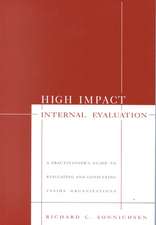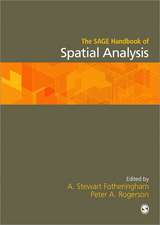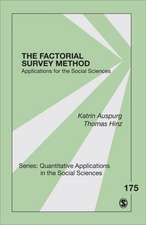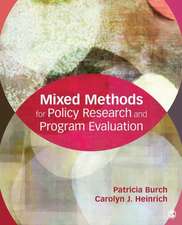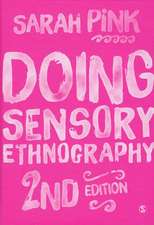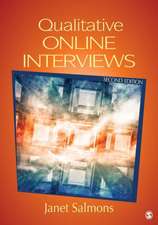Statistics in Corpus Linguistics Research: A New Approach
Autor Sean Wallisen Limba Engleză Paperback – 23 noi 2020
Accessibly written, this book discusses the ‘why’ behind the statistical model, allowing readers a greater facility for choosing their own methodologies. Accessibly written for those with little to no mathematical or statistical background, it explains the mathematical fundamentals of simple significance tests by relating them to confidence intervals. With sample datasets and easy-to-read visuals, this book focuses on practical issues, such as how to:
• pose research questions in terms of choice and constraint;
• employ confidence intervals correctly (including in graph plots);
• select optimal significance tests (and what results mean);
• measure the size of the effect of one variable on another;
• estimate the similarity of distribution patterns; and
• evaluate whether the results of two experiments significantly differ.
Appropriate for anyone from the student just beginning their career to the seasoned researcher, this book is both a practical overview and valuable resource.
| Toate formatele și edițiile | Preț | Express |
|---|---|---|
| Paperback (1) | 359.01 lei 6-8 săpt. | |
| Taylor & Francis – 23 noi 2020 | 359.01 lei 6-8 săpt. | |
| Hardback (1) | 1008.17 lei 6-8 săpt. | |
| Taylor & Francis – 23 noi 2020 | 1008.17 lei 6-8 săpt. |
Preț: 359.01 lei
Nou
Puncte Express: 539
Preț estimativ în valută:
68.69€ • 71.93$ • 56.98£
68.69€ • 71.93$ • 56.98£
Carte tipărită la comandă
Livrare economică 09-23 aprilie
Preluare comenzi: 021 569.72.76
Specificații
ISBN-13: 9781138589384
ISBN-10: 1138589381
Pagini: 382
Ilustrații: 135 Line drawings, black and white; 73 Tables, black and white; 135 Illustrations, black and white
Dimensiuni: 152 x 229 x 32 mm
Greutate: 0.51 kg
Ediția:1Adnotată
Editura: Taylor & Francis
Colecția Routledge
Locul publicării:Oxford, United Kingdom
ISBN-10: 1138589381
Pagini: 382
Ilustrații: 135 Line drawings, black and white; 73 Tables, black and white; 135 Illustrations, black and white
Dimensiuni: 152 x 229 x 32 mm
Greutate: 0.51 kg
Ediția:1Adnotată
Editura: Taylor & Francis
Colecția Routledge
Locul publicării:Oxford, United Kingdom
Public țintă
PostgraduateCuprins
Preface
1 Why Do We Need Another Book on Statistics?
2 Statistics and Scientific Rigour
3 Why Is Statistics Difficult?
4 Looking Down the Observer’s End of the Telescope
5 What Do Linguists Need to Know About Statistics?
Acknowledgments
A Note on Terminology and Notation
Contingency Tests for Different Purposes
PART 1
Motivations
1 What Might Corpora Tell Us About Language?
1.1 Introduction
1.2 What Might a Corpus Tell Us?
1.3 The 3A Cycle
1.4 What Might a Richly Annotated Corpus Tell Us?
1.5 External Influences: Modal Shall / Will Over Time
1.6 Interacting Grammatical Decisions: NP Premodification
1.7 Framing Constraints and Interaction Evidence
1.8 Conclusions
PART 2
Designing Experiments With Corpora
2 The Idea of Corpus Experiments
2.1 Introduction
2.2 Experimentation and Observation
2.3 Evaluating a Hypothesis
2.4 Refining the Experiment
2.5 Correlations and Causes
2.6 A Linguistic Interaction Experiment
2.7 Experiments and Disproof
2.8 What Is the Purpose of an Experiment?
2.9 Conclusions
3 That Vexed Problem of Choice
3.1 Introduction
3.2 Parameters of Choice
3.3 A Methodological Progression?
3.4 Objections to Variationism
3.5 Conclusions
4 Choice Versus Meaning
4.1 Introduction
4.2 The Meaning of Very
4.3 The Choice of Very
4.4 Refining Baselines by Type
4.5 Conclusions
5 Balanced Samples and Imagined Populations
5.1 Introduction
5.2 A Study in Genre Variation
5.3 Imagining Populations
5.4 Multi- Variate and Multi-Level Modelling
5.5 More Texts – or Longer Ones?
5.6 Conclusions
PART 3
Confidence Intervals and Significance Tests
6 Introducing Inferential Statistics
6.1 Why Is Statistics Difficult?
6.2 The Idea of Inferential Statistics
6.3 The Randomness of Life
6.4 Conclusions
7 Plotting With Confidence
7.1 Introduction
7.2 Plotting the Graph
7.3 Comparing and Plotting Change
7.4 An Apparent Paradox
7.5 Conclusions
8 From Intervals to Tests
8.1 Introduction
8.2 Tests for a Single Binomial Proportion
8.3 Tests for Comparing Two Observed Proportions
8.4 Applying Contingency Tests
8.5 Comparing the Results of Experiments
8.6 Conclusions
9 Comparing Frequencies in the Same Distribution
9.1 Introduction
9.2 The Single-Sample z Test
9.3 Testing and Interpreting Intervals
9.4 Conclusions
10 Reciprocating the Wilson Interval
10.1 Introduction
10.2 The Wilson Interval of Mean Utterance Length
10.3 Intervals on Monotonic Functions of p
10.4 Conclusions
11 Competition Between Choices Over Time
11.1 Introduction
11.2 The ‘S Curve’
11.3 Boundaries and Confidence Intervals
11.4 Logistic Regression
11.5 Impossible Logistic Multinomials
11.6 Conclusions
12 The Replication Crisis and the New Statistics
12.1 Introduction
12.2 A Corpus Linguistics Debate
12.3 Psychology Lessons?
12.4 The Road Not Travelled
12.5 What Does This Mean for Corpus Linguistics?
12.6 Some Recommendations
12.7 Conclusions
13 Choosing the Right Test
13.1 Introduction
13.2 Tests for Categorical Data
13.3 Tests for Other Types of Data
13.4 Conclusions
PART 4
Effect Sizes and Meta-Tests
14 The Size of an Effect
14.1 Introduction
14.2 Effect Sizes for Two-Variable Tables
14.3 Confidence intervals on ϕ
14.4 Goodness of Fit Effect Sizes
14.5 Conclusions
15 Meta- Tests for Comparing Tables of Results
15.1 Introduction
15.2 Some Preliminaries
15.3 Point and Multi-Point Tests for Homogeneity Tables
15.4 Gradient Tests for Homogeneity Tables
15.5 Gradient Tests for Goodness of Fit Tables
15.7 Conclusions
PART 5
Statistical Solutions for Corpus Samples
16 Conducting Research With Imperfect Data
16.1 Introduction
16.2 Reviewing Subsamples
16.3 Reviewing Preliminary Analyses
16.4 Resampling and p-Hacking
16.5 Conclusions
17 Adjusting Intervals for Random-Text Samples
17.1 Introduction
17.2 Recalibrating Binomial Models
17.3 Examples With Large Samples
17.4 Alternation Studies With Small Samples
17.5 Conclusions
PART 6
Concluding Remarks
18 Plotting the Wilson Distribution
18.1 Introduction
18.2 Plotting the Distribution
18.3 Example Plots
18.4 Further Perspectives on Wilson Distributions
18.5 Alternative Distributions
18.6 Conclusions
19 In Conclusion
Appendices
A The Interval Equality Principle
1 Introduction
2 Applications
3 Searching for Interval Bounds With a Computer
B Pseudo-Code for Computational Procedures
1 Simple Logistic Regression Algorithm With Logit-Wilson Variance
2 Binomial and Fisher Functions
Glossary
References
Index
1 Why Do We Need Another Book on Statistics?
2 Statistics and Scientific Rigour
3 Why Is Statistics Difficult?
4 Looking Down the Observer’s End of the Telescope
5 What Do Linguists Need to Know About Statistics?
Acknowledgments
A Note on Terminology and Notation
Contingency Tests for Different Purposes
PART 1
Motivations
1 What Might Corpora Tell Us About Language?
1.1 Introduction
1.2 What Might a Corpus Tell Us?
1.3 The 3A Cycle
1.4 What Might a Richly Annotated Corpus Tell Us?
1.5 External Influences: Modal Shall / Will Over Time
1.6 Interacting Grammatical Decisions: NP Premodification
1.7 Framing Constraints and Interaction Evidence
1.8 Conclusions
PART 2
Designing Experiments With Corpora
2 The Idea of Corpus Experiments
2.1 Introduction
2.2 Experimentation and Observation
2.3 Evaluating a Hypothesis
2.4 Refining the Experiment
2.5 Correlations and Causes
2.6 A Linguistic Interaction Experiment
2.7 Experiments and Disproof
2.8 What Is the Purpose of an Experiment?
2.9 Conclusions
3 That Vexed Problem of Choice
3.1 Introduction
3.2 Parameters of Choice
3.3 A Methodological Progression?
3.4 Objections to Variationism
3.5 Conclusions
4 Choice Versus Meaning
4.1 Introduction
4.2 The Meaning of Very
4.3 The Choice of Very
4.4 Refining Baselines by Type
4.5 Conclusions
5 Balanced Samples and Imagined Populations
5.1 Introduction
5.2 A Study in Genre Variation
5.3 Imagining Populations
5.4 Multi- Variate and Multi-Level Modelling
5.5 More Texts – or Longer Ones?
5.6 Conclusions
PART 3
Confidence Intervals and Significance Tests
6 Introducing Inferential Statistics
6.1 Why Is Statistics Difficult?
6.2 The Idea of Inferential Statistics
6.3 The Randomness of Life
6.4 Conclusions
7 Plotting With Confidence
7.1 Introduction
7.2 Plotting the Graph
7.3 Comparing and Plotting Change
7.4 An Apparent Paradox
7.5 Conclusions
8 From Intervals to Tests
8.1 Introduction
8.2 Tests for a Single Binomial Proportion
8.3 Tests for Comparing Two Observed Proportions
8.4 Applying Contingency Tests
8.5 Comparing the Results of Experiments
8.6 Conclusions
9 Comparing Frequencies in the Same Distribution
9.1 Introduction
9.2 The Single-Sample z Test
9.3 Testing and Interpreting Intervals
9.4 Conclusions
10 Reciprocating the Wilson Interval
10.1 Introduction
10.2 The Wilson Interval of Mean Utterance Length
10.3 Intervals on Monotonic Functions of p
10.4 Conclusions
11 Competition Between Choices Over Time
11.1 Introduction
11.2 The ‘S Curve’
11.3 Boundaries and Confidence Intervals
11.4 Logistic Regression
11.5 Impossible Logistic Multinomials
11.6 Conclusions
12 The Replication Crisis and the New Statistics
12.1 Introduction
12.2 A Corpus Linguistics Debate
12.3 Psychology Lessons?
12.4 The Road Not Travelled
12.5 What Does This Mean for Corpus Linguistics?
12.6 Some Recommendations
12.7 Conclusions
13 Choosing the Right Test
13.1 Introduction
13.2 Tests for Categorical Data
13.3 Tests for Other Types of Data
13.4 Conclusions
PART 4
Effect Sizes and Meta-Tests
14 The Size of an Effect
14.1 Introduction
14.2 Effect Sizes for Two-Variable Tables
14.3 Confidence intervals on ϕ
14.4 Goodness of Fit Effect Sizes
14.5 Conclusions
15 Meta- Tests for Comparing Tables of Results
15.1 Introduction
15.2 Some Preliminaries
15.3 Point and Multi-Point Tests for Homogeneity Tables
15.4 Gradient Tests for Homogeneity Tables
15.5 Gradient Tests for Goodness of Fit Tables
15.7 Conclusions
PART 5
Statistical Solutions for Corpus Samples
16 Conducting Research With Imperfect Data
16.1 Introduction
16.2 Reviewing Subsamples
16.3 Reviewing Preliminary Analyses
16.4 Resampling and p-Hacking
16.5 Conclusions
17 Adjusting Intervals for Random-Text Samples
17.1 Introduction
17.2 Recalibrating Binomial Models
17.3 Examples With Large Samples
17.4 Alternation Studies With Small Samples
17.5 Conclusions
PART 6
Concluding Remarks
18 Plotting the Wilson Distribution
18.1 Introduction
18.2 Plotting the Distribution
18.3 Example Plots
18.4 Further Perspectives on Wilson Distributions
18.5 Alternative Distributions
18.6 Conclusions
19 In Conclusion
Appendices
A The Interval Equality Principle
1 Introduction
2 Applications
3 Searching for Interval Bounds With a Computer
B Pseudo-Code for Computational Procedures
1 Simple Logistic Regression Algorithm With Logit-Wilson Variance
2 Binomial and Fisher Functions
Glossary
References
Index
Notă biografică
Sean Wallis is Principal Research Fellow and Deputy Director of the Survey of English Usage at UCL.
Recenzii
"Perfect for corpus linguists: an introduction to statistics written by one of them."
Christian Mair, University of Freiburg, Germany.
Christian Mair, University of Freiburg, Germany.
Descriere
Statistics in Corpus Linguistics Research: A new approach breaks down the fundamentals of statistics for researchers in corpus linguistics and linguistic analysis. It promotes a visual approach to understanding the performance of tests with real data, demonstrating how to derive new intervals and tests.


